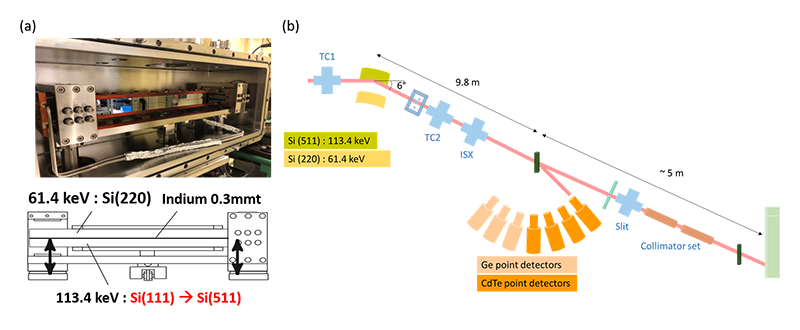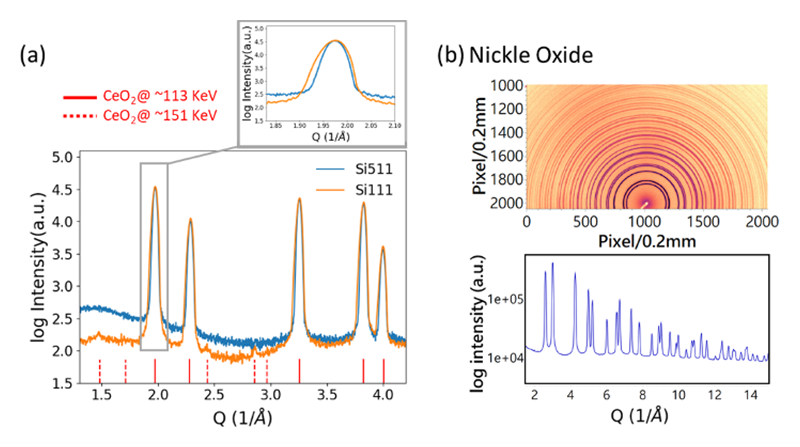Volume 28, No.3 Pages 326 - 328
3. SPring-8/SACLA通信/SPring-8/SACLA COMMUNICATIONS
Update on the Monochromator at BL04B2, SPring-8
[1](公財)高輝度光科学研究センター 放射光利用研究基盤センター 回折・散乱推進室 Diffraction and Scattering Division, Center for Synchrotron Radiation Research, JASRI、[2](公財)高輝度光科学研究センター ビームライン技術推進室 Beamline Division, JASRI、[3]島根大学 材料エネルギー学部 Faculty of Materials for Energy, Shimane University
1. Introduction
BL04B2 is currently equipped with a bending magnet that limits the horizontal divergence of beam to 0.34 mrad by a slit for high-energy X-ray total scattering experiments. To prioritize the X-ray flux in the high-energy region above 60 keV, two horizontal bent Bragg monochromators have been used: Si(111) and Si(220), fixed at a 3° angle (Figure 1a). Both Si(111) and Si(220) crystals are affixed onto a crystal holder equipped with water cooling, alongside an indium (In) sheet to achieve effective thermal stability. The Si(220) monochromator selects the first harmonic of reflective X-ray to monochromate the X-ray energy to 61.4 keV, while the Si(111) monochromator selects the third harmonic, resulting in an energy of 113.4 keV. Positioned 46 m downstream from the X-ray source, the monochromator can be adjusted to have a variable radius of curvature ranging from 320 m to 430 m. By modifying the radius of curvature, the focal point in the experimental hutch can be altered between 10 - 15 m from the monochromator (Figure 1b).

Figure 1 (a) Current setting of two monochromators at BL04B2. (b) The layout of BL04B2 beamline.
2. Update on the monochromator
The use of a bent monochromator with a single leaf at BL04B2 employs the same mechanism as a mirror-adjusting monochromator, enabling lateral focusing by bending the crystal in the meridional direction. However, when conducting measurements at 113.4 keV using the Si(111) monochromator, contamination from higher harmonics of reflective X-rays, such as Si 444 at 151.2 keV (dotted line), was observed (Figure 2a). To resolve this issue while maintaining the 3° angle of the monochromator stage, the Si(511) monochromator was introduced as a replacement. By utilizing the first harmonic of reflective X-rays with Si(511), the X-ray energy can be maintained at 113.4 keV, and the resulting diffractions from the third harmonic reflective X-rays occur at angles that are too small to be observed. This substitution can effectively eliminate the diffractions caused by high-harmonic X-ray contamination in an experimental result (Figure 2a). By bending the monochromator to focus the beam at around a 10 m focal point and using two slits along the beam path, it allows for limiting the beam size to 2 mm × 2 mm. A well-focused beam results in a narrower peak shape, as demonstrated by the measurement of CeO2 using Si(511) monochromatic X-ray, compared to those obtained using Si(111) as shown in the inset of Figure 2a. The energy resolution calculated by∆E/E = cotθB•∆θ, can be estimated as 2 × 10-3 at focal point of 10 m from monochromater [1, 2][1] M. Isshiki et al.: Nuclear Instruments and Methods in Physics Research A 467-468 (2001) 663-666.
[2] E.-E. Koch: Handbook on Synchrotron Radiation, North-Holland, Amsterdam (1983)..

Figure 2 (a) CeO2 measurements conducted at 2-axis system at BL04B2 before and after substituting the monochromators. The dotted lines show the reflections from high harmonic Si 444 X-ray. (b) X-ray diffraction image data and integrated pattern of NiO measured at flat-panel detector system at BL04B2 using Si(511) monochromator.
The improvement in reducing diffraction intensities from high-harmonic X-ray contamination, on the other hand, brings the added benefit of implementing a flat-panel detector at BL04B2. To demonstrate this, measurements of nickel oxide using the flat-panel detector system were carried out (Figure 2b). Both the raw image data and the integrated X-ray pattern show that no diffractions originating from high-harmonic X-rays were observed when the Si(511) monochromator was utilized.
3. Conclusion
In summary, the replacement of the monochromator at BL04B2 with Si(511) brings benefits to both 2-axis point detectors and flat-panel detector systems by eliminating X-ray peaks resulting from high-harmonic X-ray contamination, while maintaining the X-ray energy at 113.4 keV. The energy resolution at BL04B2 can be calculated as 2 × 10-3 with the focus beam of 2 mm × 2 mm at 2-axis system.
References
[1] M. Isshiki et al.: Nuclear Instruments and Methods in Physics Research A 467-468 (2001) 663-666.
[2] E.-E. Koch: Handbook on Synchrotron Radiation, North-Holland, Amsterdam (1983).
(公財)高輝度光科学研究センター
放射光利用研究基盤センター 回折・散乱推進室
〒679-5198 兵庫県佐用郡佐用町光都1-1-1
TEL : 0791-58-0833
e-mail : jochi.tseng@spring8.or.jp
(公財)高輝度光科学研究センター
放射光利用研究基盤センター 回折・散乱推進室
〒679-5198 兵庫県佐用郡佐用町光都1-1-1
TEL : 0791-58-0833
e-mail : h_yamada@spring8.or.jp
(公財)高輝度光科学研究センター
ビームライン技術推進室
〒679-5198 兵庫県佐用郡佐用町光都1-1-1
TEL : 0791-58-0831
e-mail : hohashi@spring8.or.jp
(公財)高輝度光科学研究センター
ビームライン技術推進室
〒679-5198 兵庫県佐用郡佐用町光都1-1-1
TEL : 0791-58-0831
e-mail : yamazaki@spring8.or.jp
(公財)高輝度光科学研究センター
放射光利用研究基盤センター 回折・散乱推進室
〒679-5198 兵庫県佐用郡佐用町光都1-1-1
TEL : 0791-58-2839
e-mail : tamasaku@spring8.or.jp
(公財)高輝度光科学研究センター
放射光利用研究基盤センター 回折・散乱推進室
島根大学 材料エネルギー学部
〒690-8504 島根県松江市西川津町1060
TEL : 0852-32-6655
e-mail : ohara@mat.shimane-u.ac.jp








